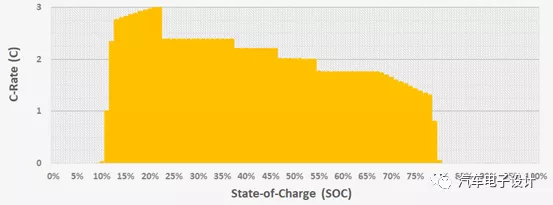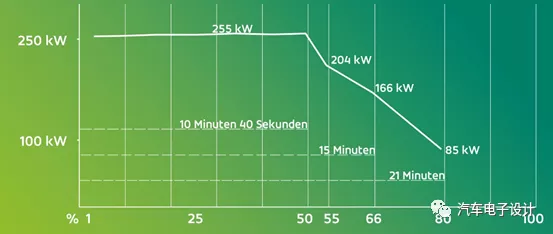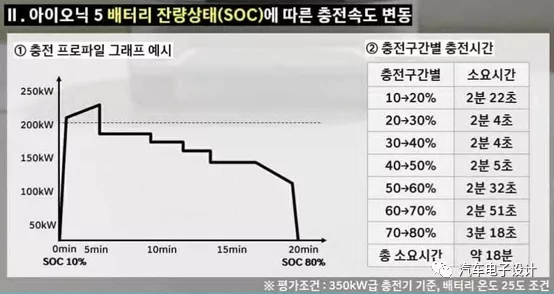Abstract
The fast charging curve of the modern Ioniq has been released, showing that this 77 kWh electric vehicle can indeed be fast charged at a rate of about 10% to 80% in 18 minutes. A decomposition table is provided in the figure below.
- Time from 10% to 50%: 8 minutes and 35 seconds
- Time from 30% to 80%: 13 minutes and 46 seconds
Note: It is unknown how the charging time will be affected by temperature. Currently, it should be designed based on normal temperature.
Change back to the original format, which may have better effects.
Charging Power and Time Allocation
As shown in Figure 1, we can analyze it in detail. The maximum charging power is 232 kW, which is designed based on a peak rate of 3C converted from 77 kWh. According to Inside EV’s calculation, this also exceeds 2.6C at around 12%, and reaches 3C at around 25%. The range that exceeds 2C is from 11% to 55%, and gradually decreases after 55%, and begins to decline after 80%.

This curve looks similar to the Taycan, but due to the heat generated by the sustained 3C charging, the time that the high power is maintained is shorter. Although the power here is less than the Taycan’s 270 kW, the battery is also smaller. Under 800 V, it’s all about the fast charging characteristics of the battery itself and how can it dissipate heat.
Note: At the same level of battery cells, the fast charging level of SK and LG Chem are almost the same, and the dispute between the two is because their products can be directly replaced (like Apple to Apple).

Vehicle Interface for Ioniq 5
At the auto show, I visited the E-GMP booths of both Hyundai and Kia and found some subtle differences. Hyundai’s booth displayed the high-voltage interface of the E-GMP (while Kia’s E-GMP did not show a high-voltage interface).## E-GMP’s High Voltage Interface
The high-voltage interface of E-GMP is designed with windows on the front and rear sides of the tray for installing and sealing the high and low voltage connectors. The connectors for front and rear drives are identical. In addition, there is a high voltage accessory interface and a charging machine interface on both sides of the rear, within which an ICCU is installed for bidirectional charging and discharging management, which is equivalent to an auxiliary connection. Note that there is a similar small distribution box integrated into the front drive shaft, which is estimated to be allocated to PTC and compressor.
On the rear driver, Hyundai has integrated a dedicated distribution box. The line output from the high voltage charging interface is bridged with the output interface from the battery to the inverter in this integrated PDU. Two fast charging contactors may need to be placed in this small box.
Here is a direct issue. Many car companies realize front and rear distribution through battery packs, which means that it is necessary to achieve the use of long copper bars or wires inside the battery pack, which inevitably compresses the overall space range that the battery can be arranged in.
Summary
The approach of high voltage wiring around the battery pack is also a relatively simple method. This is also seen in the design of the BEV3 battery system of General Motors. In fact, the core is the placement of the fast charging port, and the future front-drive, rear-drive, four-wheel drive, and high-performance four-wheel drive in terms of the powertrain, which determines how the high voltage architecture will be laid out, how the high voltage interface will be arranged, and how the protective devices inside will be designed.
This article is a translation by ChatGPT of a Chinese report from 42HOW. If you have any questions about it, please email bd@42how.com.
